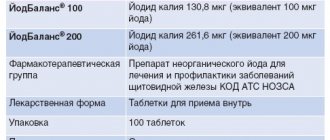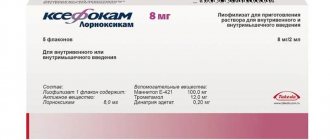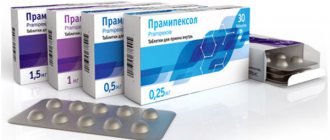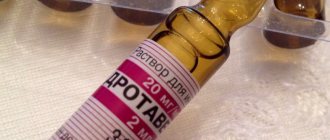Pharmacological properties of the drug Ferrum lek
Iron supplement. Contains iron Fe3+ in the form of a complex compound of iron (III) hydroxide with polymaltose (HPA). The iron in the polynuclear "core" is associated with a structure similar to serum ferritin. This macromolecular complex is stable and under physiological conditions does not release iron in the form of free ions. Therefore, when taken orally, iron, which is part of the GPC, enters the blood from the intestine only through active absorption. There is a correlation between the degree of iron deficiency and the amount of iron absorbed (the higher the iron deficiency, the better the absorption). It is this property of the drug that explains the impossibility of poisoning with the drug even in the case of an overdose, unlike simple iron salts, the absorption of which occurs along a concentration gradient. Maximum absorption of iron after oral administration occurs in the duodenum and jejunum, and its absorption is not reduced by interaction with certain food components or with drugs containing a phenolic group (for example, tetracycline). Iron administered in the form of HPA is slowly absorbed and enters the blood serum, from where it quickly passes into iron-depositing tissues. Absorbed iron is stored bound to ferritin, mainly in the liver. Later in the bone marrow it is included in hemoglobin. In hemoglobin, iron is in divalent form, but it is Fe3+ (trivalent iron) that stimulates the formation of globin, which ultimately helps to increase hemoglobin levels. Since iron in the dosage form for oral administration is contained in non-ionized form, the drug does not have such side effects as irritation of the mucous membrane of the digestive tract, staining of tooth enamel, and the appearance of a metallic taste in the mouth. Chewable tablets and syrup are characterized by a high degree of safety and are well tolerated by patients. Comparative studies of the bioavailability of Ferrum Lek oral dosage forms using the radioisotope method, as well as comparative clinical trials, have proven that the absorption and bioavailability of iron in the form of iron (III) hydroxide complex with polyisomaltose is equivalent to the absorption and bioavailability of iron (II) salts.
How the medicine works and its composition
The main component is iron in the form of polyisomaltose hydroxide. Its quantity in 1 ampoule is 100 mg. An auxiliary component is purified water. When performing an injection, ferric iron is delivered to the body in the form of a complex of ferric hydroxide with dextran.
The drug is effective only for anemia, the cause of which is the low content of this microelement. As a result, hemoglobin synthesis is restored, which allows the process of oxygen delivery to tissues to be normalized. At the same time, their nutrition is restored. This is due to the fact that iron affects the process of oxygen uptake.
Hemoglobin is a protein that is part of red blood cells. These red blood cells transport oxygen and remove carbon dioxide. Thanks to these processes, tissue respiration is maintained, without which their development is impossible.
In addition, when a drug containing iron is administered, metabolism at the cellular level is restored.
Thanks to it, the function of enzymes and proteins is normalized, which helps eliminate toxins, maintain cholesterol metabolism and energy metabolism.
Containing sufficient iron helps eliminate the weakness that occurs due to iron deficiency anemia. The drug allows you to improve your appearance: when administered, the elasticity of the skin is restored, cracks and peeling disappear, and dryness disappears. At the same time, hair fragility is eliminated and shine returns. An iron supplement helps improve appetite. At the same time, the body’s resistance to the effects of harmful microorganisms increases, which eliminates the tendency to colds.
Thanks to the drug, the functioning of the gastrointestinal tract is restored, shortness of breath disappears, which is a direct consequence of oxygen deficiency. After a course of injections, dizziness goes away and the tendency to faint disappears. Considering that iron affects all organs and systems, promotes the formation of blood cells, by replenishing the deficiency of this element, health improves.
The drug Ferumlek has the advantage that it does not contribute to the release of free iron ions. The active component in its composition is similar to its natural analogue - ferritin. Taking this remedy allows you to gradually reduce the intensity or eliminate the negative manifestations characteristic of an iron deficiency state. At the same time, normalization of blood composition is noted.
The body's rapid response to the introduction of the solution is due to the immediate entry of the iron complex into the blood. After just 15 minutes, the concentration of the active component is 15%, after 30 minutes it increases to 44%.
Indications for use of the drug Ferrum lek
Orally prescribed for the prevention and treatment of iron deficiency conditions of various etiologies, including the prevention of iron deficiency in children, women of childbearing age (especially during pregnancy and breastfeeding), adults (especially vegetarians) and the elderly; treatment of iron deficiency anemia. Ferrum Lek for parenteral administration is indicated for the treatment of iron deficiency conditions that require rapid and reliable compensation of iron deficiency: severe posthemorrhagic anemia, impaired iron absorption, as well as when treatment of iron deficiency anemia with oral iron preparations is ineffective. Ferrum Lek is used in patients with clear indications for the drug, with mandatory determination of the level of ferritin in the blood plasma and the number of red blood cells in the peripheral blood. If iron malabsorption is suspected, an iron absorption test should be performed.
Use of the drug Ferrum lek
The dose and duration of taking the drug depend on the severity of iron deficiency. Tablets and syrup for the treatment of iron deficiency conditions are prescribed in the usual daily dose: adults and children over 12 years of age in the absence of clinical signs of anemia - 10 ml of syrup or 1 tablet per day, in the presence of clinical signs of anemia - 30 ml of syrup per day or 1 tablet 3 times a day; children aged 1–12 years - at the rate of 3 mg of iron per 1 kg of body weight per day or 5–10 ml of syrup per day; it is recommended that syrup be prescribed to infants in an initial dose of 10 drops per day, gradually increasing the dose to 5 ml (1 teaspoon of syrup) per day. A teaspoon of syrup contains 100 drops. Women during pregnancy or breastfeeding are prescribed 20–30 ml of syrup or 1–3 tablets per day.
Patients | Treatment of iron deficiency | Prevention of iron deficiency | ||
Pills | Syrup | Pills | Syrup | |
| Children under 1 year of age | 2.5–5 ml/day | — | — | |
| Children aged 1–12 years | 5–10 ml/day | — | — | |
| Adults and children over 12 years old | 1–3 tablets per day | 10–30 ml/day | — | — |
| Women during pregnancy and breastfeeding | 1–3 tablets per day | 20–30 ml/day | 1 tablet per day | 5–10 ml/day |
The duration of use of chewable tablets or Ferrum Lek syrup is at least 3 months after normalization of the peripheral blood composition to restore the iron depot in the body (course of treatment is 6 months). To prevent iron deficiency conditions, the usual dose for pregnant and breastfeeding women is 5–10 ml of syrup or 1 tablet per day. Solution for IM administration IV administration of the solution is contraindicated! Before administering the first therapeutic dose of the drug, its tolerability is determined by administering a test dose - 1/4–1/2 from an ampoule of Ferrum Lek (which corresponds to 25–50 mg of iron) for adults and half the daily dose for children. If no undesirable effects develop over the next 15 minutes, administer the remainder of the initial daily dose. 1 ) first, calculate the total iron deficiency (TID) (mg): TID = TI + ID, where TI is iron included in hemoglobin, mg: TI is = MT (CZG - AIG) 0.24, where MT body weight (kg); CZH - target hemoglobin value, g/l (for body weight up to 35 kg - 130 g/l, for body weight more than 35 kg - 150 g/l); AUC —actual hemoglobin level, g/l; coefficient 0.24 = 0.0034 • 0.07 • 1000, where 0.34% is the iron content in hemoglobin; 7% - total blood volume as a percentage of body weight; 1000 is the conversion factor from grams to milligrams; ID - deposited iron, mg (for body weight up to 35 kg - 15 mg per 1 kg of body weight, for body weight more than 35 kg - 500 mg); 2) calculate the total number of ampoules per course of treatment (OCA): OKA = OCA: 100, where 100 is the iron content in 1 ampoule, mg. Calculation example: body weight = 70 kg; actual hemoglobin level = 80 g/l; iron included in hemoglobin - 70 • 0.24 • (150 – 80) = 1200 mg of iron; deposited iron - 500 mg of iron; general iron deficiency - 1200 + 500 = 1700 mg of iron; the total number of ampoules per course of treatment is 1700: 100 = 17. Table for calculating the total number of ampoules for one patient per course of treatment.
Body weight, kg | Total number of Ferrum Lek ampoules per course of treatment | |||
Hb = 60 g/l | Hb = 75 g/l | Hb = 90 g/l | Hb =150 g/l | |
| 5 | 1,5 | 1,5 | 1,5 | 1,0 |
| 10 | 3,0 | 3,0 | 2,5 | 2,0 |
| 15 | 5,0 | 4,5 | 3,5 | 3,0 |
| 20 | 6,5 | 5,5 | 5,0 | 4,0 |
| 25 | 8,0 | 7,0 | 6,0 | 5,5 |
| 30 | 9,5 | 8,5 | 7,5 | 6,5 |
| 35 | 12,5 | 11,5 | 10,0 | 9,0 |
| 40 | 13,5 | 12,0 | 11,0 | 9,5 |
| 45 | 15,0 | 13,0 | 11,5 | 10,0 |
| 50 | 16,0 | 14,0 | 12,0 | 10,5 |
| 55 | 17,0 | 15,0 | 13,0 | 11,0 |
| 60 | 18,0 | 16,0 | 13,5 | 11,5 |
| 65 | 19,0 | 16,5 | 14,5 | 12,0 |
| 70 | 20,0 | 17,5 | 15,0 | 12,5 |
| 75 | 21,0 | 18,5 | 16,0 | 13,0 |
| 80 | 22,5 | 19,5 | 16,5 | 13,5 |
| 85 | 23,5 | 20,5 | 17,0 | 14,0 |
| 90 | 24,5 | 21,5 | 18,0 | 14,5 |
If the total number of Ferrum Lek ampoules exceeds the maximum daily dose, it is necessary to divide the administration of the drug into several doses. If after 1–2 weeks of therapy there is no normalization of blood counts, it is necessary to reconsider the established diagnosis. Calculation of the total dose of Ferrum Lek for intramuscular injection to replenish iron losses due to blood loss. The required number of ampoules is calculated using the following formulas:
- If the amount of blood lost is known, the administration of 200 mg of iron IM (2 ampoules) causes an increase in hemoglobin levels by 1 unit of blood (400 ml 150 g/l hemoglobin content). Required amount of iron (mg) = number of blood units lost • 200 or required number of Ferrum Lek ampoules = number of blood units lost • 2.
- If a reduced hemoglobin level is known , use the formula for calculation, assuming that there is no need to replenish stored iron: required amount of iron (mg) = body weight (kg) • (target hemoglobin value [g/l] - actual hemoglobin level [g/l ]) • 0.24. For patients weighing 60 kg with a hemoglobin deficiency of 10 g/l, the required amount of iron is 150 mg or 1.5 ampoules of Ferrum Lek.
The usual dose of Ferrum Lek for intramuscular administration : Children: 0.6 ml of the drug per 1 kg of body weight per day (3 mg of iron per 1 kg of body weight per day). Adults and elderly patients: contents of 1-2 ampoules of Ferrum Lek (100-200 mg iron) depending on the hemoglobin level. Maximum daily dose of Ferrum Lek for intramuscular administration Children: 0.14 ml of the drug per 1 kg of body weight per day (7 mg of iron per 1 kg of body weight per day). Adults: 4 ml of the drug (contents of 2 ampoules) Ferrum Lek. Ferrum Lek for intramuscular injection is administered every other day, deep intramuscularly, alternately into the left and right gluteal muscles. Before use, carefully check the ampoule visually. It is allowed to use only a transparent solution that does not contain sediment. If sediment appears and after the expiration date indicated on the package, the ampoule is not suitable for use. The ampoule is opened immediately before injection. The IM injection is performed slowly to avoid pain and staining of the skin, into the upper outer quadrant of the buttock with a needle 5–6 cm long. Before the injection, wipe the skin with alcohol, pull it to the side by 2 cm so that after removing the needle the injection channel is covered with skin to prevent fluid from leaking into the subcutaneous fat. During injection, the pulled skin is gradually released; after the injection, the injection site is pressed for 1 minute.
How to give an injection
Before giving the first injection intravenously or intramuscularly, a drug tolerance test is performed. In this case, a small dose of the substance is administered (no more than 1/2 ampoule). For a child, half the daily amount is prescribed. If no negative reactions occur, administer the remaining amount of the single dose.
Instructions for use:
- the dosage is determined by the doctor taking into account the hemoglobin level (determined in the laboratory);
- if there is a need to use a dose that exceeds the permissible daily dose, it is allowed to administer the drug in parts;
- The duration of the course of treatment is determined individually, however, if within 2 weeks the blood counts remain the same, you should consult a doctor and the treatment regimen should be changed.
Minimum daily doses: for children up to 7 mg of iron per 1 kg of body per day, for adults - up to 4 ml.
Contraindications to the use of the drug Ferrum lek
Hypersensitivity to the drug , anemia not caused by iron deficiency, including hemolytic; hypersensitivity to any of the components of the drug; excess iron in the body (hemochromatosis, hemosiderosis); disorders of hemoglobin synthesis (anemia caused by lead poisoning, sideroblastic anemia), thalassemia; severe hemostasis disorders (hemophilia); oral administration is not advisable when there is a decrease in the concentration of iron in the blood serum and anemia caused by a chronic inflammatory process or neoplasm.
Pharmacological characteristics of the drug
The drug contains iron, which has a valence of 3+. The microelement eliminates anemia associated with a lack of iron in the patient’s body and increases the amount of hemoglobin. The drug promotes the disappearance of clinical signs of anemia in mild cases of the disease, when hemoglobin decreases to 90 g/l.
The medication can be prescribed by a doctor for moderate anemia, when the microelement deficiency is in the range of 70-90 g/l.
The drug belongs to protein products, represented by a protein and hydroxyl polymaltose complex of a trivalent element. Iron salts 3+ are not absorbed into the gastrointestinal tract. The nonionic complex is similar to the structure of the natural compound of the element and ferritin. The trivalent composition enters the blood from the intestines through the process of active absorption.
Pharmacokinetics
After an intramuscular injection, the medicine penetrates into the bloodstream, most of the drug is distributed in the tissues 30 minutes after administration. The drug is removed from the body after 4 days. The microelement, combining with transferrin, enters the cells and is used for the formation of hemoglobin and some enzymes.
The combination of iron hydroxide with dextran is not removed through the kidneys. Absorption of the drug is proportional to the volume of the administered substance. The largest amount of medication is absorbed in the duodenum. The remaining drug is removed from the body with feces.
Side effects of Ferrum Lek
Usually well tolerated, side effects are mostly transient and mild. Gastrointestinal disorders such as a feeling of heaviness and fullness in the stomach, distension in the epigastric region, nausea, constipation or diarrhea are very rarely observed. Dark coloration of stool caused by iron supplementation is not clinically significant. With intramuscular administration, arterial hypotension, arthralgia, swollen lymph nodes, fever, headache, dizziness, and infiltrate at the injection site rarely occur; very rarely - anaphylactic and anaphylactoid reactions.
Side effects
Estimated incidence of side effects: > 10% – very common; > 1% and < 10% – often; > 0.1% and < 1% – uncommon; > 0.01% and < 0.1% – rare; <0.01% – very rare; with an unknown frequency – if it is impossible to estimate the frequency of occurrence of violations.
Syrup, tablets
In most cases, Ferrum Lek is well tolerated; adverse reactions that develop are mild and transient:
- skin and subcutaneous tissue: very rarely - rash, urticaria, itching of the skin;
- digestive system: very rarely - diarrhea, constipation, abdominal pain, nausea, vomiting, dyspepsia, change in the color of feces (associated with the excretion of iron that is not absorbed; has no clinical significance).
Injection solution
Possible disorders: malaise, fever, dizziness, headache, hypotension, joint pain, swollen lymph nodes, dyspepsia (in the form of nausea and vomiting).
In extremely rare cases, the development of allergic or anaphylactic reactions is observed.
Incorrect injection technique of Ferrum Lek can lead to skin staining, inflammation and pain at the injection site.
Special instructions for the use of the drug Ferrum Lek
1 tablet contains 0.04 XE, 1 ml of syrup - 0.04 XE. Each Ferrum Lek tablet contains 1.5 mg of aspartame (a precursor to phenylalanine), and may therefore have an adverse effect on patients with phenylketonuria. In controlled trials, the use of the drug in the second and third trimester of pregnancy did not have a negative effect on the fetus. Iron is released into breast milk in the form of a complex with lactoferrin, only a small amount of iron from the complex of iron (III) hydroxide with polymaltose passes into breast milk in ionized form, so the occurrence of side effects in an infant when the mother takes Ferrum Lek is unlikely. Parenteral administration of iron preparations can cause the development of allergic reactions. For an allergic reaction of moderate severity, the administration of antihistamines is recommended. If an anaphylactic reaction develops, immediate administration of epinephrine is indicated. The risk of developing anaphylaxis is quite high in patients with asthma, Crohn's disease, polyarthritis, reduced iron binding capacity and/or folic acid deficiency.
Interactions of the drug Ferrum lek
Do not mix the solution for intramuscular administration with other medications; Like other iron preparations for parenteral use, Ferrum Lek is not prescribed simultaneously with iron preparations for oral administration. The interval between parenteral use of the drug and the start of use of oral dosage forms of iron should be at least 5 days. Since iron is included in the drug in the form of a complex of iron (III) hydroxide with polymaltose, when taken in the form of chewable tablets or syrup, it does not form insoluble chelate compounds with components of food products (phytin, oxalates, tannin) or medicines (tetracyclines, antacids ).
Release form, packaging and composition
The medication is released in the form of a brown solution. The substance in the ampoules is homogeneous and does not contain foreign ingredients. The drug contains an active component - iron (III) hydroxide polyisomaltose. 1 ampoule contains 100 mg of active ingredient.
An additional ingredient is water for injection.
To adjust the pH of the solution use:
- hydrochloric acid (concentrated);
- or sodium hydroxide in the form of a 6M solution.
Ferrum Lek product, 5 or 50 ampoules each, is placed in a cardboard package. Instructions for use are included with the medicine.
Ferrum lek overdose, symptoms and treatment
With parenteral administration, hemosiderosis may develop. Incorrect diagnosis of anemia as iron deficiency can lead to iron overdose. In case of an overdose of tablets or syrup, symptoms of acute poisoning can develop in extremely rare cases, since iron from HPA is absorbed not through passive diffusion, but through active transport, and the degree of absorption of iron from HPA directly depends on the severity of iron deficiency. Treatment is symptomatic; a specific iron antidote is the chelating agent deferoxamine.









